How to calculate the power of the air conditioner and choose the right unit for your needs
A competent calculation of the power of the air conditioner is the key to effective, uninterrupted operation and durability of climate equipment. The choice of performance is based on the overall dimensions of the room and related factors contributing to the accumulation of thermal radiation.
Taking into account all the parameters and nuances of operation allows us to provide for an optimal power reserve, but at the same time not to overpay for the super-performance of the split system.
But how to make the necessary calculations? We will consider this issue in detail in our article. In addition to two methods for calculating power, let us dwell on other important criteria that affect the choice of an air conditioner.
The content of the article:
- What do the power values in the documentation say?
- BTU value and label interpretation
- Power Consumption and Energy Efficiency Assessment
- Self-power calculation methods
- Step-by-step calculations of equipment power
- Additional criteria for choosing an air conditioner
- Conclusions and useful video on the topic
What do the power values in the documentation say?
In the technical documentation for air conditioners, two or three types of power are indicated. The indicators characterize different operating parameters: cold and heat output, as well as the electric power consumed by the split system.
The scatter of indicators can be misleading. In heating appliances, such as a boiler or radiator, the heat output corresponds to the energy consumed. For an air conditioner, these parameters are different.
The split complex, unlike the heater, does not directly convert electricity, but uses it to operate the heat pump. The latter is able to pump heat much more than the consumed electric power.

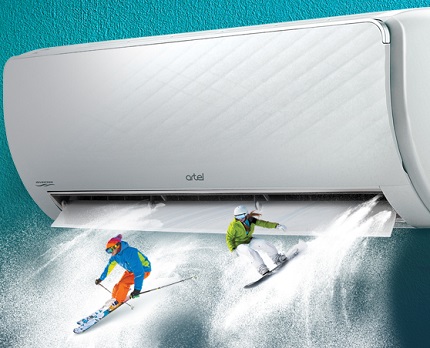
Cooling power is indicated in kW, the range of household equipment values is 2-8 kW. In addition, many manufacturers in the technical specifications use the British marking - BTU (BTU).
The cooling capacity of the split must be appropriate to the conditions of service. Otherwise, normalizing the microclimate to a given temperature will become an overwhelming task for the air conditioner and will damage the equipment.
Two scenarios are possible:
- low productivity - unit operation on the verge of possibilities;
- excess power - an increase in the number of on / off, which adversely affects the electric motor.
The ability to heat a room characterizes the thermal conductivity of a split. The heat transfer power is always slightly higher than the cooling capacity. The difference between the indicators is the ratio of heat loss on the freon flow path in the cooling and heating modes.
The thermal power indicator is especially relevant if the air conditioner is planned to be used as an off-season heating source. The split complex is several times more effective than an electric heater. About the features of the split system for heat we talked here.
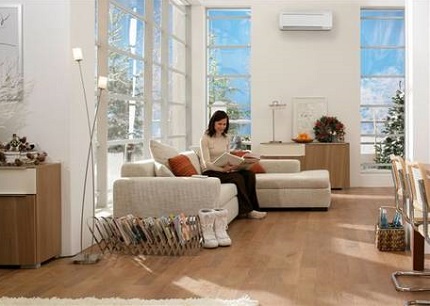
BTU value and label interpretation
BTU / BTU - British thermal unit for measuring heat energy. The value determines the amount of heat spent heating one pound of water per 1 ° Faringate.
It is this unit that expresses the cooling capacity of HVAC equipment and is often present in product labeling.
The ratio between W and BTU / h:
- 1 BTU / h ≈ 0.2931 W, for the convenience of calculation, 0.3 W is used;
- 1 kW ≈ 3412 BTU / h.
Air conditioning is an American invention using a Western system of measures. For practicality and visualization of the display, the cooling capacity was decided to standardize and express in round numbers, for example: 7000 BTU / h, 9000 BTU / h, etc.
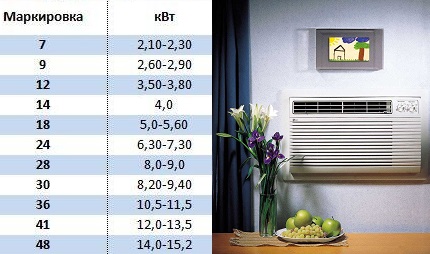
Understanding the digital designation in the labeling of equipment, it will be possible to approximately determine which room the air conditioner is designed for.
Power Consumption and Energy Efficiency Assessment
As noted above, in addition to cold and heat production, the power consumption is indicated in the split system passport. The value determines the energy consumption. We recommend that you read the rules calculating electricity consumption and ways to save it.
However, the coefficient and class of energy efficiency are more informative.
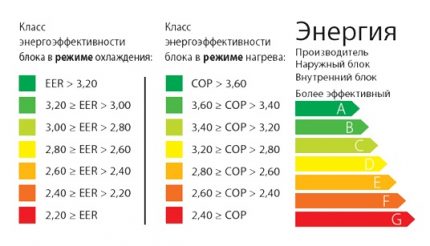
In fact, the coefficients Eer and COP show the amount of cold / heat produced while consuming 1 kW of electrical power. The higher their numerical value, the higher the efficiency of the climate system and the lower the level of energy consumption.
That is, when EER = 2.5 air conditioning at maximum cooling power consumes electricity Q / 2.5. Multiplying the result by the period of work, you can find out the daily energy consumption.
Based on the EER, splits are classified into energy efficiency classes. The most economical units are assigned to category “A”, the “G” group is represented by air conditioners with the highest electricity consumption.
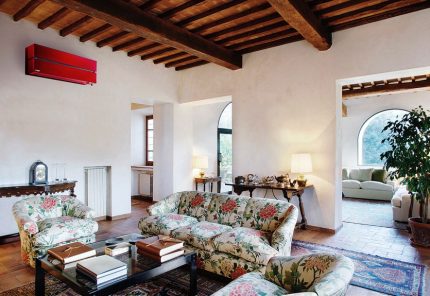
Self-power calculation methods
There are several ways to calculate split performance. The simplest but not reliable enough is the calculation of the area. More accurate is the heat engineering method, taking into account the design features of the room and the total heat inflows.
Option # 1 - choosing an air conditioner by service area
The approximate power of the unit can be determined without mathematical calculations, appealing with a practical evaluation criterion - the area of the room.
The average cooling capacity of the split is 1 kW per 10 sq. M of the serving room. This norm is relevant for residential premises with a ceiling height of 2.5-3 m.
Thus, when calculating the power of the air conditioner, the service area must be divided by 10. For example, for a room of 22 sq.m, a model with a capacity of 2.2 kW is suitable. The obtained value corresponds to the “seven” according to the BTU system.
TDP is increased by 20% in the following cases:
- the location of the room on the sunny side of the house;
- the presence of panoramic windows;
- placement of a large number of office equipment, electrical appliances.
A supply of cooling capacity of 20% must be provided if a lot of people constantly live or work in the room.
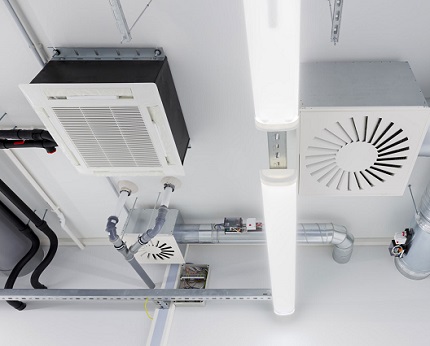
Due to the impressive dimensions, possible angularity and curvature, air flows are distributed unevenly. In this case, it is advisable to install multisystem split complexes.
Option # 2 - using heat calculation
Thermotechnical calculation is considered more accurate taking into account the structural and operational features of the building. Next, consider the typical formula used for calculations.
Determining factors:
- room dimensions: area and exact height;
- number of people;
- purpose of the room: gym, active work, rest, etc .;
- heat sources, household / office equipment;
- the presence of insulated facades and roofs.
The main emphasis in assessing the power of the air conditioner is on the total heat gain.
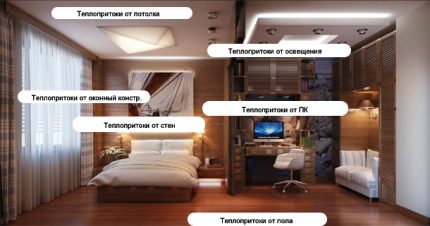
The greater the heat flux, the higher the cooling capacity of the split should be.
Typical formula:
Q = Q1 + Q2 + Q3,
Where: Q - total cooling power; Q1 - heat from structural elements of the room; Q2 - heat influx from people; Q3 - heat dissipation from technology.
Step # 1 - Calculating Q1
The heat of the room is determined as follows:
Q1 = V * g,
Where: V - the volume of the premises served, calculated by the product of a square footage and the ceiling height; g - estimated heat transfer coefficient.
The value of g depends on the orientation of the windows and the level of natural light in the room:
- 40 - sunny side, intense insolation is characteristic of the south, southwest, southeast orientation;
- 35 - moderate illumination of the eastern, northwestern, western side;
- 30 - the predominance of shading during the day is observed in rooms whose windows face north or northeast.
As you can see, for the sunny side there will be the highest heat transfer coefficient.
Step # 2 - Defining Q2
The heat production of people depends on their age and mobility.
For an adult, the following heat dissipation indicators are characteristic:
- idle state - 80 W;
- light work, moderate loads - 125 W;
- active activity - 170 watts.
When doing hard work and intense sports exercises, heat production reaches 250 watts.
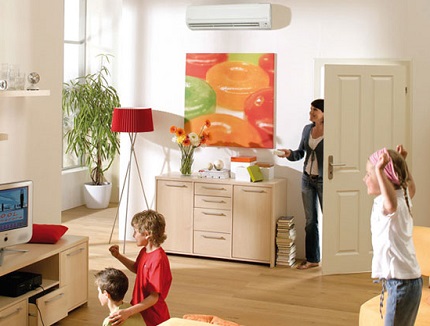
However, this approach is justified when choosing a split system in child care facilities.Air conditioning is purchased for the future, so for the family, the heat transfer of children should be equated with "adult" indicators.
For an apartment cooling system, the parameter Q2 is determined by the product of the number of residents by the average heat release value - about 110 watts.
Step # 3 - calculate Q3
Heat surplus from electrical equipment is calculated by the formula:
Q3 = N * m * i,
Where:
- N - power of a unit of equipment;
- m - the number of household appliances;
- i - the coefficient of conversion of electricity into heat.
In the calculations, it is necessary to take into account the frequency of use of equipment during the day, taking round-the-clock work as a unit.

Summing up the total heat gain, you can determine the power of the air conditioner. It is permissible to exceed the cooling capacity of the unit by 15% of the calculated indicator or reduce it by a maximum of 5%.
Step-by-step calculations of equipment power
First, we will calculate the necessary equipment capacity for a particular room with an area of 24 sq.m. And then we will consider in what situations corrections are used.
Power calculation for a specific room
The calculated data for determining the performance of the split:
- room area - 24 sq. m, ceiling height - 2.8 cm;
- a room with a standard window facing south;
- number of residents - 2 people;
- equipped with appliances: computer, TV, refrigerator (0.3 kW), incandescent lamp (0.1 kW).
The simultaneous operation of the listed electrical appliances is possible.
Step 1 - determination of heat from windows, floors, walls and ceilings.
Q1 = 24 * 2.7 * 40 = 2592 W
The resulting value can be safely rounded up to 2.6 kW. The coefficient g = 40 is used in the calculation, since the room is well lit.
Step 2 - calculation of heat gain from people. We take the heat production of an adult for 110 watts.
Q2 = 2 * 110 = 220 W or 0.22 kW
Step 3 - heat inflows from equipment are calculated for each type of equipment, taking into account the conversion factor of electricity:
- computer - 0.3 kW;
- TV - 0.2 kW;
- an electric lamp - 90 W (100 W * 0.9);
- refrigerator - 100 W (300 W * 0.3).
Q3 = 300 + 200 + 90 + 100 = 600 W or 0.6 kW
Step 4 - calculation of the cooling capacity of the air conditioner.
Q = 2.6 + 0.22 + 0.6 = 3.42 kW
For comparison, it is possible to make an approximate selection of an air conditioner solely by area without taking into account the number of living and heat inflows. For an area of 24 square meters, the estimated cooling capacity should be 2.4 kW, taking into account good illumination - 2.4 * 1.2 = 2.88 kW.
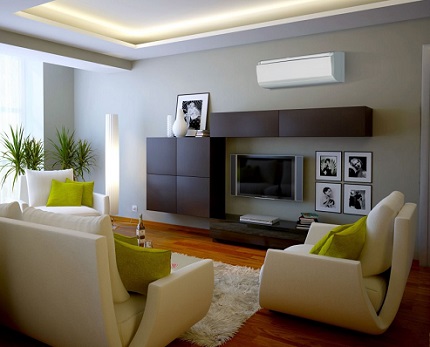
In this situation, the calculation results for the two methods differ. Priority is “thermal” computing. The cooling capacity of the air conditioner should extinguish all possible heat input.
Special conditions
The technique described above in most cases does not need to be adjusted and gives an accurate result.
Special attention deserves:
- the need for regular ventilation;
- the location of the premises on the top floor;
- hot climate of the region;
- large glazing area.
We consider all these cases in more detail.
Fresh air
The documentation for split systems usually stipulates that operation of the device with open windows is undesirable.
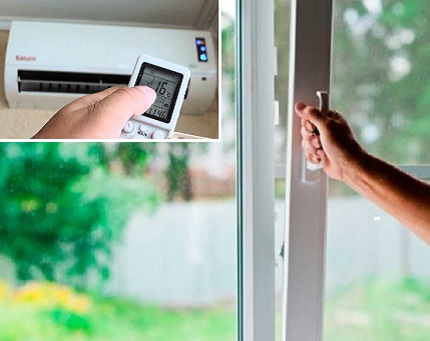
To maintain a normal microclimate without constantly moving the sash, you can leave the window on micro-ventilation or mount supply valve. Both options do not provoke drafts when the front door is closed.
When operating a split in conditions of gentle ventilation it is necessary to consider:
- In order to compensate for the additional heat load, Q1 in calculating the power of the air conditioner must be increased by 20%.
- Electricity consumption during split operation will increase to 15%.
In hot weather, you should not rely on the power reserve. With significant heat influx, the air conditioner will not provide the set temperature.
Upper floor of the dwelling
In the attics and apartments of the last floors without an attic, the heat of the heated roof is transferred inside the room. The situation is aggravated by the presence of flat roofs of a dark color.

Hot climate of the region
One of the rules for the safe use of air conditioning is to comply with the permissible temperature difference outside and inside the building. The limit of the value is 10 ° C. For example, if the window is 35 ° C, then the recommended room temperature is at least 25 ° C.
The rated power of split complexes is indicated taking into account operation in conditions up to 31-33 ° С. With an increase of up to 40 ° C and more, the cooling capacity of the unit is not enough to maintain the treasured 18-20 ° C.
Given the predisposition of the climate to sultry summers and their own preferences for the level of coolness, in the calculations, the indicator Q1 should additionally be increased by 20-30%.
Large windows in the room
The standard formula assumes the presence in the room of one window of standard dimensions - up to 2 sq.m. Several window openings or a panoramic design increases unaccounted heat gain.

Adjustment of the cooling capacity is carried out based on each square meter of additional glazing:
- + 200-300 W - for the sunny side;
- + 100-200 W - moderate insolation of the room;
- + 50-100 watts - the prevalence of shading.
Reducing solar heat gains will help light blinds or curtains.
Additional criteria for choosing an air conditioner
In addition to the power characteristics of the system and the energy efficiency class, before buying, you should decide on the following parameters:
- type of air conditioner;
- the principle of operation of the unit;
- functionality;
- manufacturer company.
Next, we consider in more detail each of these criteria.
Criterion # 1 - type of air conditioner
For domestic use monoblocks and split systems. The first category includes window models and compact portable devices. Air conditioners built into the window have lost their former popularity.
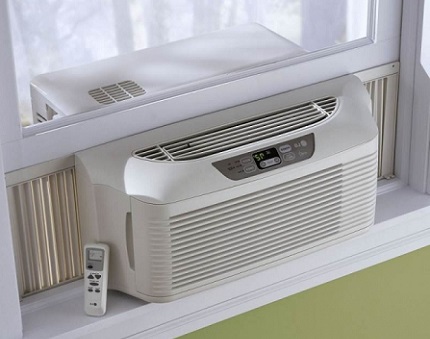
Indisputable advantages of window “coolers”: low cost and maintainability. Such a unit is more suitable for seasonal summer cottage use than for an apartment.
Mobile monoblocks are equipped with a flexible duct that removes heat to the street. Portable air conditioning - the best solution for a rented space. Rating of the best mobile models we brought in this article.
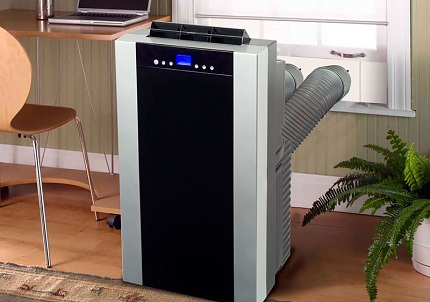
Split systems confidently occupy a leading position among domestic air conditioning systems.
According to the form of performance, there are two categories of splits:
- Two-block design. A pair of modules is connected by a freon closed line. The complex is easy to operate and virtually silent. Different design options for the indoor unit are available, the case does not occupy the usable area in the room.
- Multi system. An external module provides operation of two to five indoor units.
The use of a multi-complex allows you to set various air conditioning parameters in individual rooms.
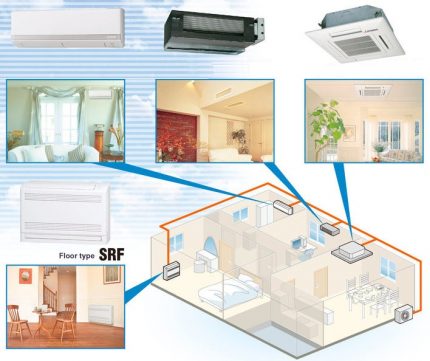
Criterion # 2 - principle of operation
Distinguish between conventional and inverter models.
The operation procedure of a traditional split system:
- When the temperature rises, the air conditioner turns on.
- After cooling to the designated aisle, the unit turns off.
- The on / off duty cycle is repeated continuously.
And here inverter air conditioner functions more "smoothly". After starting, the room cools down, but the device continues to work with reduced power, maintaining the desired temperature.

Due to the absence of a “sharp” cycle of operation, inverter air conditioners are quiet and durable.
You don't know either which is better to choose - inverter or conventional air conditioning? In this case, we recommend that you familiarize yourself with their main differences, as well as the pros and cons of each option.
Criterion # 3 - Features and Brand
Manufacturers, in an effort to win the favor of customers, equip split systems with additional options.
It is good if the air conditioner has the following functions:
- fan distribution of air flow;
- automatic restoration of device settings;
- remote control;
- built-in timer.
Another of the features of the air conditioner that is in demand among users is fresh air. Many manufacturers offer such models.
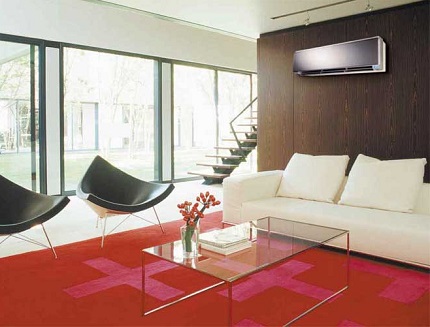
The equipment manufacturer plays a significant role in the selection - the better the brand reputation, the higher the quality indicators and the reliability of the equipment.
Foreign companies prevail in the ranking of leading manufacturers: Daikin, LG, Sharp, Hitachi, Panasonic and General Climat. The best models of air conditioners we reviewed in the next article.
Conclusions and useful video on the topic
Practical recommendations of a specialist will help determine the power characteristics of the air conditioner:
Understanding the principles of calculating the performance of air conditioning systems, it will be possible to independently determine the range of permissible power.
It is better to entrust the final calculation of suitable parameters to professionals - an experienced specialist will take into account all operational nuances and select the optimal model of air conditioning.
Do you need air conditioning, but you do not want to miscalculate with power and choose insufficiently productive equipment in the apartment / house? Maybe you still have questions about the calculations or want to clarify certain nuances? Ask for advice in the comments - our experts and competent site visitors will try to clarify all the points.

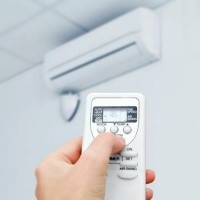 Gree air conditioner error codes: how to decipher the fault symbol and repair the unit
Gree air conditioner error codes: how to decipher the fault symbol and repair the unit 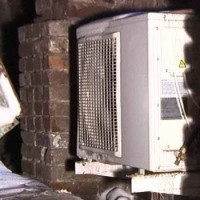 Installation of an external air conditioning unit in the attic: the possibility of solving and analysis of technical specifics
Installation of an external air conditioning unit in the attic: the possibility of solving and analysis of technical specifics 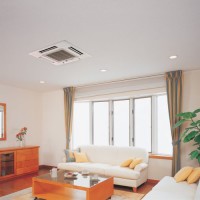 How to build an air conditioner route: communications device specifics
How to build an air conditioner route: communications device specifics 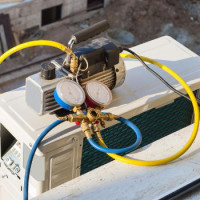 Do-it-yourself evacuation of the air conditioner: technology for work + valuable recommendations
Do-it-yourself evacuation of the air conditioner: technology for work + valuable recommendations 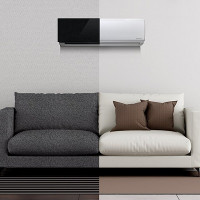 The difference between an inverter air conditioner and an ordinary one: their advantages and disadvantages + which is better to choose
The difference between an inverter air conditioner and an ordinary one: their advantages and disadvantages + which is better to choose 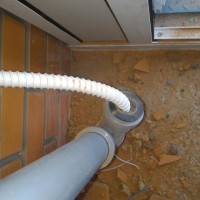 Condensate drainage from the outdoor unit of the air conditioner: organization methods and best technological solutions
Condensate drainage from the outdoor unit of the air conditioner: organization methods and best technological solutions  How much does it cost to connect gas to a private house: the price of organizing gas supply
How much does it cost to connect gas to a private house: the price of organizing gas supply  The best washing machines with dryer: model rating and customer tips
The best washing machines with dryer: model rating and customer tips  What is the color temperature of light and the nuances of choosing the temperature of the lamps to suit your needs
What is the color temperature of light and the nuances of choosing the temperature of the lamps to suit your needs  Replacement of a geyser in an apartment: replacement paperwork + basic norms and requirements
Replacement of a geyser in an apartment: replacement paperwork + basic norms and requirements
I always dreamed of buying an air conditioner in the house, but I was worried that I could not regulate the comfortable air temperature well enough and risk seriously catching a cold. But then I found out that this does not depend on temperature, but on insufficient maintenance of the equipment, which results in a good environment for the development of harmful bacteria. This device is very useful in the summer, when there is high humidity outside, the air is unbearable. In order for the air conditioner to last for a long time and without health consequences, it is necessary to carry out regular cleaning, at least once a month. I would like the author to supplement and give detailed recommendations on cleaning the air conditioner, this is very important information.
There is such an article, Valentina, on the site - you can study: “DIY split-system cleaning: routine inspection and maintenance».
Some do not recognize the usefulness of an air conditioner and suffer from heat, saving themselves with an ordinary fan, but in vain. If you just turn it off, it gets worse. Therefore, they came up with air conditioning, and they specially developed several types. We have an inverter version, it is really silent, maintains a comfortable temperature and is not fastidious in operation. Choosing the right power can save a lot of energy. Do not spare money for comfort.
Wow, what subtle calculations for the selection. Today, I first heard about the fact that when choosing an air conditioner, you need to count something. Especially this info will be relevant for sellers of these very splits, since in most cases they sell simply: - “What is your area? we have 25 sq.m, well then this model is perfect for you. ” ))))
Well, sellers in chain stores are guided by the simplest formula - 1 kW of power per 10 sq.m. Yes, it works, but for apartments up to 60 sq.m. In general, the seller should not be involved in calculating the power of an air conditioner or split system. It is very rare when a consultant in an electronics hypermarket will be well disassembled in air conditioners, washing machines, computers and other things at the same time.
For a one-room apartment, one air conditioner will be enough, calculation according to the service area. And for a two-room apartment or more, as well as for a private house, it is better to use thermal calculations. There is already no consultant in the store will not help, you need to attract a specialist and pay money for the work. In this case, a multisplitsystem is the optimal solution.
Air conditioning manufacturers, Alexander, are guided by the average dimensions of the apartments, replacing the volume with "square meters". The average American ceiling, for example, is 2.4 meters, and the Japanese - 2.1. Old Russian apartments had a height of 2.6 meters, modern - 2.4. However, they promise to bring to 2.8. As you can see, the spread is small from the world average height, but the increase in volume may turn out to be critical for the air conditioner.